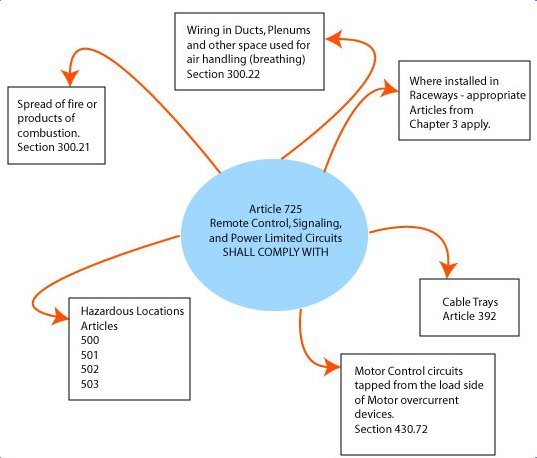
|
|
|

|
|
|
 igure 1 graphically illustrates requirements that must be kept in mind when
doing control wiring subject to the Code. Section 300.21 requires that
fire stopping be restored when fire rated walls, ceilings and floors are penetrated.
This requires, in most cases, that a listed fire stopping method be used.
This may be using a fire stopping caulking compound or other more elaborate
assemblies such as used with cable tray penetrations. The UL Fire Resistance
Directory describes many fire stopping methods and assemblies that have been
tested and listed. These tests measure the time it takes for the temperature
to rise to a specific temperature on the far side away from the fire for
a specific fire rated assembly, and the time it takes for the flames to pass
through the assembly. Throughout the Code there are no exceptions for
restoring the fire rating after a penetration has been made.
igure 1 graphically illustrates requirements that must be kept in mind when
doing control wiring subject to the Code. Section 300.21 requires that
fire stopping be restored when fire rated walls, ceilings and floors are penetrated.
This requires, in most cases, that a listed fire stopping method be used.
This may be using a fire stopping caulking compound or other more elaborate
assemblies such as used with cable tray penetrations. The UL Fire Resistance
Directory describes many fire stopping methods and assemblies that have been
tested and listed. These tests measure the time it takes for the temperature
to rise to a specific temperature on the far side away from the fire for
a specific fire rated assembly, and the time it takes for the flames to pass
through the assembly. Throughout the Code there are no exceptions for
restoring the fire rating after a penetration has been made.
The fire rating of a wall may be compromised by installing a flush mounted
control panel in the wall unless some approved method is used for the installation.
One approved method that has been used is to line the panel cavity with
sheet rock equivalent to that used on the walls.

When Class 2 circuits are installed in a hazardous location they must
be installed just like power circuits in a hazardous location unless the
circuits are also rated as intrinsically safe or nonincendive. Intrinsically
Safe circuits have specific requirements in the Code in Article 504.
Unless intrinsically safe circuits have been also tested and listed as Class
2 circuits, they are not Class 2 circuits.


|

|

|

|